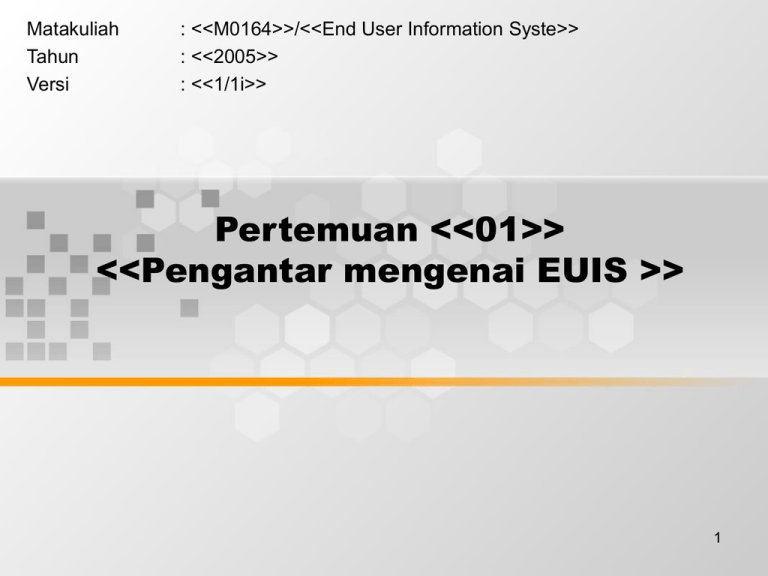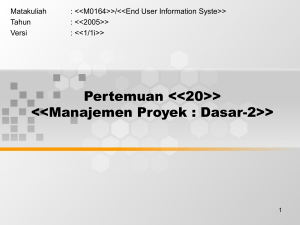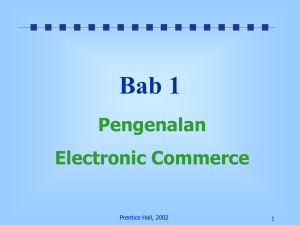Matakuliah : <<M0164>>/<<End User Information Syste>> Tahun : <<2005>>
advertisement

Matakuliah Tahun Versi : <<M0164>>/<<End User Information Syste>> : <<2005>> : <<1/1i>> Pertemuan <<01>> <<Pengantar mengenai EUIS >> 1 Learning Outcomes Pada akhir pertemuan ini, diharapkan mahasiswa akan mampu : • Mahasiswa dapat menerangkan Konsep dasar EUIS, posisinya dalam SI perusahaan dan peluang karir 2 Outline Materi • Definisi EUIS, hubungan dengan SI lainnya • Lingkungan di era digital : • Knowledge Worker • Peran Organisasi • Perubahan Organisasi • Dampak pada perubahan kerja • group support 3 End-User Information Systems: Implementing Individual and Work Group Technologies Textbook by: Elizabeth A. Regan, Ph.D, Bridget N. O’Connor, Ph.D. Supported by student resource Web Site: www.prenhall.com/regan Back 1-4 Copyright Prentice Hall, 2002 Next End I End-User Information Systems: Organizational and Technical Foundations Back 1-5 Copyright Prentice Hall, 2002 Next End Introduction to End-User Information Systems Back 1-6 Copyright Prentice Hall, 2002 Next End Learning Objectives • Define end user information systems (EUIS) and explain how it relates to other areas of information systems. • Explain how EUIS fits into an overall enterprise information systems architecture. • Identify the benefits of end-user information systems. • Understand how end-user information systems relate to changing roles and expectations in the workplace. • Explain how business processes addressed by enduser information systems differ from those handled by large data centers and transmission processing systems. Back Next End More… 1-7 Copyright Prentice Hall, 2002 Learning Objectives 2 • Describe the changing requirements (characteristics) of work in the Information Age. • Describe the impact of end-user information systems on workplace environments. • Understand the relationship between workplace performance and technology. • Explain the concept of Help Desk and assistance centers. • Identify career opportunities in the area of enduser information systems. Back 1-8 Copyright Prentice Hall, 2002 Next End Introduction • Information Age –Knowledge –Core Competencies • Information Systems –End-User Information Systems (EUIS) –Knowledge Work Systems Back 1-9 Copyright Prentice Hall, 2002 Next End End-User Information Systems 1. 2. 3. 4. 5. 6. 7. 8. 9. 10. 1-10 Productivity tools for knowledge workers Work group computing End-user development End-user training End-user support – Help Desk, information center Knowledge management/performance support Human factors and ergonomics Business process and job (re)design Change management Project management Back Next End Copyright Prentice Hall, 2002 EUIS Tools • • • • • Text handling/document management Data handling tools Multimedia/Graphic and Design Communication tools Group systems/Collaborative technologies • Time management • Knowledge management/performance support Back 1-11 Copyright Prentice Hall, 2002 Next End Enterprise Information Systems 1. Transaction processing systems (TPS) 2. Management Information Systems (MIS) 3. Decision Support Systems (DSS) 4. Executive Information Systems (EIS) 5. End-user information systems (EUIS), or Knowledge work systems (KWS) Back 1-12 Copyright Prentice Hall, 2002 Next End Typical IS Organization Structure Enterprise Operations & Networks • Computer center operations • Networks • IS planning and architectures • Data repositories • Technical support IS Applications Development • Enterprise applications • Transactions processing systems (TPS) • Management reporting systems • End-user information systems • Internet, Intranet, Extranet Back 1-13 Copyright Prentice Hall, 2002 Next End Converging Information Technologies 1950 1960 1970 1980 1990 1-14 Copyright Prentice Hall, 2002 2000 Integrated Information Systems Back Next End Knowledge Workers Who are Knowledge Workers? • Executive and managerial personnel • Professional and technical knowledge workers • Sales and marketing personnel • Administrative support, including clerical Changes in Labor Force Composition Back 1-15 Copyright Prentice Hall, 2002 Next End Role of Organizations • Coordinate efforts • Contribute to enterprise’s goals • Brings together resources • Creation of synergy Structure depends upon… – Nature of tasks – Knowledge & skills of the staff – Technology & resources available Back 1-16 Copyright Prentice Hall, 2002 Next End Changing Organizational Structure Historical Organizational Hierarchy Management Supervisory Professional Technical Production/Clerical is changing to… 1-17 Copyright Prentice Hall, 2002 Back Next End Changing Organizational Structure Information Age Organizational Hierarchy Management Supervisory Staff Professional/Technical and Sales Staff Knowledge Workers Clerical Staff Back 1-18 Copyright Prentice Hall, 2002 Next End Typical Functional Divisions Personnel Operations Financial Operations Production Operations Computer Information Systems Executive Management Legal Services Marketing Research And Development Administrative Services Back 1-19 Copyright Prentice Hall, 2002 Next End Knowledge Work Environment Characteristics: 1. 2. 3. 4. 5. 6. 7. 8. 9. Variability Work styles Departmentalization Dispersed Specializations Nonproductive activities Soft information Deadline pressures Project versus production environments Back 1-20 Copyright Prentice Hall, 2002 Next End Impact of EUIS on Work • EUIS and Business Value • EUIS and Human Factors • EUIS and Job/Work Process Design • EUIS and Organizational Change Back 1-21 Copyright Prentice Hall, 2002 Next End EUIS Project Management Steps • • • • • • • • 1-22 Defining project scope Plan the project Assess the requirements Design: Detailed description of solution Select or develop the solution Convert and implement the solution Evaluate the results Institutionalize the results Copyright Prentice Hall, 2002 Back Next End Staffing and Managing EUIS • • • • • Who is responsible for EUIS IS Organizations Information Technology Architecture Help Desks and Information Centers Role of Chief Information Officer (CIO) • Career Opportunities in EUIS Back 1-23 Copyright Prentice Hall, 2002 Next End Key Terms: • • • • • • • • • • • 1-24 Summary Application Business process (re)design Business system Chief information officer (CIO) Digital age Digital divide End users End-user computing (EUC) End-user information systems (EUIS) Executive information systems (EIS) Help Desk Copyright Prentice Hall, 2002 • Information Age • Information technology infrastructure • Information processing • Knowledge workers • Knowledge worksystems (KWS) • Management information systems (MIS) • Primary functions • Support functions • Transaction processing systems (TPS) • Work flow analysis Back Next End Next: Life in Networked Organizations Back 1-25 Copyright Prentice Hall, 2002 Next End << PENUTUP>> Selanjutnya Pert. 02 DASAR DASAR EUIS 26

